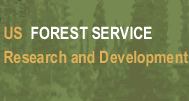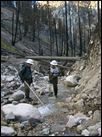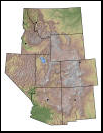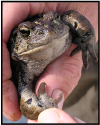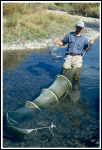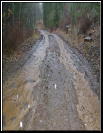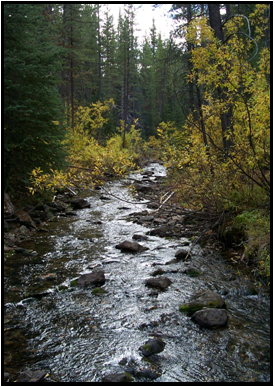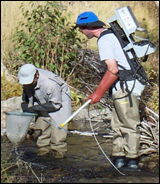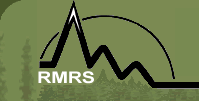

|
AWAE Program Headquarters Boise, ID 83702 (208) 373-4340
(970) 295-5923 |
|
|
|
|
|
Rocky Mountain Research Station Home > Science Program Areas > Air, Water and Aquatics
Air, Water and Aquatic Environments Science Program
about AWAE The RMRS Air, Water, and Aquatic Environments (AWAE) Science Program is committed to the development of knowledge and science applications related to air and water quality, as well as the habitat quality, distribution, diversity, and persistence of fish and other aquatic species. Mission Statement: To develop and apply scientific knowledge to support management, conservation, and restoration of terrestrial, riparian and aquatic ecosystems while optimizing air and water quality and delivery in the Interior West. More about AWAE
Upper Verde River: Review of Stream-Riparian Monitoring Efforts Conducted by the U.S. Forest Service Rocky Mountain Research Station
A review of RMRS research and monitoring efforts on the Upper Verde River, Arizona
AWAE Scientists are leaders in integrating research in fisheries, geomorphology, hydrology, plant physiology and soil science.
Research includes Fluvial Geomorphology and Watershed Processes, Stream-Riparian Environmental Research, Watershed Hydrology in Natural, Disturbed, and Managed Systems, Soil Erosion and Fuels Management, Forest Roads and Erosion, Ecophysiology of Forest Ecosystems, Aquatic Ecology, ESA Fish, Hydrology and Erosion, Engineering Geomorphology and Landslides, Atmospheric Deposition and Natural Ecosystems, Semi-Arid Watersheds, Watershed Biogeochemical Research, Processes that Affect Fish Distributions, Fire and Erosion, Sediment Transport Processes, Native Fish, Sampling, and Conservation Biology. More information about each Scientist and their projects Research Field Unit Locations located throughout the interior west each contribute to the AWAE science program research.
Albuquerque Lab, Boise Lab, Flagstaff Lab, Fort Collins Lab, Missoula Lab, Moscow Lab
A list of AWAE program research projects, themes, science and special projects can be found here: AWAE Program Research Projects
This information is being continually updated. If you can't find a Briefing Paper or Focus Paper that you are looking for, please contact us.
featured Science
Bull Trout and Climate Change - Risks, Uncertainties and Bull trout are a federally listed, native charr species distributed throughout the Pacific Northwest. Among the critical requirements for this species are a need for large, interconnected habitats of cold water. Much uncertainty exists regarding the future of bull trout and their habitats given environmental trends associated with a warming climate and increasing fire activity. Presentations at this symposium provide an overview of bull trout, their relationship to climate, and alternatives for modeling future habitat and population distributions. Videos and Abstracts of the 2008 Western Division Meeting of the American Fisheries Society
Clean Water - Insect Outbreaks and Watersheds
Invasive Species Managing for Native Trout
Invasive Species are one of the most important threats
Air Quality in Mountain Ecosystems - Ozone
Hyporheic exchange (the mixing of streamflow and shallow groundwater) is poorly understood in gravel-bed rivers. These channels are particularly important habitat for salmonids, many of which are currently at risk worldwide and which incubate their offspring within the hyporheic zone.
Boreal Toad populations are declining and are difficult to observe. Factors such as understanding their ecology and developing monitoring tools are critical.
Remotely Assessing and Monitoring Channel Physical Habitat NASA’s Experimental Advanced Airborne Research Lidar (EAARL) was used to continuously map three-dimensional channel and floodplain topography, in streams that provide spawning habitat of a federal listed (threatened) population of Chinook salmon. Data were acquired over 200 km of streams in low-flow conditions with high water clarity in October, 2004, in Idaho’s Bear Valley Creek, a tributary stream in the upper Middle Fork Salmon River drainage.
Bull Trout and Climate Change Bull trout are an ESA listed species that may be especially vulnerable to the effects of a warming climate. As such they may be a useful biological indicator of the effects climate change will have on mountain stream ecosystems. Understanding threats to persistence of bull trout will help us understand threats to other species and ecosystems —information that will be key to prioritization of limited management resources.
Nonnative brook trout have invaded and replaced native cutthroat trout in many Rocky Mountain streams. Methods to remove brook trout, such as chemical treatment and intensive electrofishing, are expensive, time-consuming, and sometimes controversial. An alternative technique used in control of unwanted insects, pheromone lures and traps, may be applicable to fish.
Forest roads are the principle source of anthropogenic fine sediment entering streams on Forest Service lands. How do we efficiently locate, quantify and prioritize these sediment sources for remediation?
Briefing Paper | GRAIP Website
Stream thermal regimes are important within regulatory contexts and strongly affect aquatic ecosystems. Numerous approaches have been developed for modeling stream temperatures, but broad application of these models to USFS lands has been constrained by data limitations and poor predictive ability. RMRS scientists have developed an approach to modeling stream temperatures that requires a minimum of field effort by using existing temperature records in combination with GIS and remote sensing technologies. The approach is being applied in a central Idaho watershed to map thermal habitat networks for native fish species, but could also be used to forecast future habitat distributions, improve understanding of factors affecting stream temperatures, determine compliance with water quality standards, or optimize temperature sampling strategies. Monitoring bull trout populations Bull trout are native to much of the Pacific Northwest, but population declines during the 20th century prompted listing under the Endangered Species Act. Several national forests have also selected bull trout as a Management Indicator Species, which makes monitoring a priority. Monitoring protocols have traditionally focused on tracking site level abundance, but these approaches can be costly to apply across broad areas and are being replaced in some instances by distributional monitoring. Researchers at the Boise Aquatic Sciences Lab have adapted distributional approaches for bull trout to create a monitoring protocol that can be applied rapidly and inexpensively while providing powerful trend detection across broader areas relevant to land management.
Science For Kids, Parents and Teachers The Forest Service kicked off a national “Get Outdoors” campaign in February, to encourage children and their parents to take advantage of recreational opportunities on national forests to develop a healthier lifestyle and learn about conserving natural resources. The RMRS Air, Water, and Aquatic Environments Science Program is doing our part in educating children about our natural resources. Get Outdoors - The Boise River Experience
|
|
Rocky Mountain Research Station
- Air, Water and Aquatic Environments Sciences Program
Last Modified:
Thursday, 15 January 2009 at 17:25:17 EST
